Is There a Historical Relationship Between Urban Growth and Resilience Loss? The Case of Floods in Belo Horizonte (Brazil)
Abstract
1. Introduction
2. Case Study
3. Methodology
3.1. Information Gathering
3.2. Hydrological Modelling
4. Results and Discussion
4.1. The Historical Evolution of Landscape Transformation
4.2. The Historical Co-Evolution of Territorial Transformation and Flooding
4.3. Is There a Relationship Between Increased Flood Frequency and Changes in Rainfall Patterns?
4.4. Is There a Relationship Between the Increase in the Frequency and Magnitude of Floods in the Arrudas Catchment in Relation to Historical Changes in Land Use?
4.5. Where Should Decisions Be Directed to Move Towards a More Sustainable and Resilient City?
5. Conclusions
Author Contributions
Funding
Institutional Review Board Statement
Informed Consent Statement
Data Availability Statement
Conflicts of Interest
References
- Macklin, M.G.; Lewin, J. The rivers of civilization. Quat. Sci. Rev. 2015, 114, 228–244. [Google Scholar] [CrossRef]
- Plazas, C. La Sociedad Hidráulica Zenú: Estudio Arqueológico de 2.000 Años de Historia en las Llanuras del Caribe Colombiano; Banco de la República, Museo del Oro: Bogotá, Colombia, 1993; 299p, ISBN 9589028926. [Google Scholar]
- Kidder, T.R.; Liu, H. Bridging theoretical gaps in geoarchaeology: Archaeology, geoarchaeology, and history in the Yellow River valley, China. Archaeol. Anthropol. Sci. 2017, 9, 1585–1602. [Google Scholar] [CrossRef]
- Salazar-Galán, S.; Mascort-Albea, E.; Sánchez-Fuentes, D. Post-COVID-19 territorial redefinition: Resilience in the face of risks and imbalances in urban-rural patterns. Rev. EURE—Rev. Estud. Urbano Reg. 2022, 48, 1–9. [Google Scholar] [CrossRef]
- Di Baldassarre, G.; Kooy, M.; Kemerink, J.S.; Brandimarte, L. Towards understanding the dynamic behaviour of floodplains as human-water systems. Hydrol. Earth Syst. Sci. 2013, 17, 3235–3244. [Google Scholar] [CrossRef]
- Di Baldassarre, G.; Viglione, A.; Carr, G.; Kuil, L.; Salinas, J.L.; Blöschl, G. Socio-hydrology: Conceptualising human-flood interactions. Hydrol. Earth Syst. Sci. 2013, 17, 3295–3303. [Google Scholar] [CrossRef]
- Plate, E.J. Flood Risk and Flood Management. J. Hydrol. 2002, 267, 2–11. [Google Scholar] [CrossRef]
- Rentschler, J.; Avner, P.; Marconcini, M.; Su, R.; Strano, E.; Vousdoukas, M.; Hallegatte, S. Global evidence of rapid urban growth in flood zones since 1985. Nature 2023, 622, 87–92. [Google Scholar] [CrossRef]
- Tingsanchali, T. Urban Flood Disaster Management. Procedia Eng. 2012, 32, 25–37. [Google Scholar] [CrossRef]
- Pinos, J.; Quesada-Román, A. Flood risk-related research trends in Latin America and the Caribbean. Water 2021, 14, 10. [Google Scholar] [CrossRef]
- Schiermeier, Q. Droughts, heatwaves and floods: How to tell when climate change is to blame. Nature 2018, 560, 20–22. [Google Scholar] [CrossRef]
- Lahsen, M.; Ribot, J. Politics of attributing extreme events and disasters to climate change. Wiley Interdiscip. Rev. Clim. Change 2022, 13, e750. [Google Scholar] [CrossRef]
- Alves, P.B.; Amanguah, E.; McNally, D.; Espinoza, M.; Ghaedi, H.; Reilly, A.C.; Hendricks, M.D. Navigating the definition of urban flooding: A conceptual and systematic review of the literature. Water Sci. Technol. 2024, 90, 2796–2812. [Google Scholar] [CrossRef]
- González de Molina, M.; Toledo, V.M. Environmental History as Sustainability Science. In The Social Metabolism: A Socio-Ecological Theory of Historical Change, 2nd ed.; Springer International Publishing: Cham, Switzerland, 2023; pp. 9–46. ISBN 978-3-031-48410-0. [Google Scholar]
- Sanchez-Calderon, V.; Blanc, J. Latin American Environmental History: Change and Continuity in a Growing Field. Hist. Crítica 2019, 74, 3–18. [Google Scholar] [CrossRef]
- Aragón-Durand, F. Inundaciones en Zonas Urbanas de Cuencas en América Latina, 1st ed.; Soluciones Prácticas: Lima, Peru, 2014. [Google Scholar]
- Fernández Illescas, C.; Buss, S. Ocurrencia y Gestión de Inundaciones en América Latina y el Caribe-Factores Claves y Experiencia Adquirida; Nota Técnica N° IDB-TN-924; Banco Interamericano de Desarrollo, División de Agua y Saneamiento: Washington, DC, USA, 2016. [Google Scholar]
- Novillo Rameix, N. Climate change and environmental social conflicts in intermediary cities of Latin America and the Caribbean. Let. Verdes Rev. Latinoam. Estud. Socioambient. 2018, 24, 124–142. [Google Scholar] [CrossRef]
- Serna Quintana, C.A. The social nature of floods and landslides in Medellín (1930–1990). Hist. Crítica 2011, 43, 198–223. [Google Scholar] [CrossRef]
- Capilé, B.; Sedrez, L.F. Water labour: Urban metabolism, energy and rivers in nineteenth-century. In More-Than-Human Histories of Latin America and the Caribbean: Decentring the Human in Environmental History; de Carvalho Cabral, D., Vasques Vital, A., Gascón, M., Eds.; University of London Press: London, UK; pp. 119–139. ISBN 978-1-915249-52-4.
- Brailovsky, A. Buenos Aires, Ciudad Inundable; Capital Intelectual: Buenos Aires, Argentina, 2010; 248p. [Google Scholar]
- Vitz, M. A City on a Lake: Urban Political Ecology and the Growth of Mexico City; Duke University Press: Durham, NC, USA, 2020. [Google Scholar]
- dos Santos, F.A. Inundações na cidade de São Paulo, uma construção social. Histórica 2015, 62, 15–22. [Google Scholar]
- Instituto Brasileiro de Geografia e Estatística. Estimates of the Resident Population in Brazilian Municipalities with a Reference Date of 1 July 2025. Available online: https://servicodados.ibge.gov.br/api/docs/pesquisas (accessed on 11 August 2025). (In Portuguese)
- McDonald, D.L. The origins of informality in a Brazilian planned city: Belo Horizonte, 1889–1900. J. Urban Hist. 2021, 47, 29–49. [Google Scholar] [CrossRef]
- Borsagli, A.; Prado, I.; Granceri Bradaschia, M. The City of Waters: Art, Perceptions, and Historical–Geographical Studies on the Hydrographic Network of Belo Horizonte (Brazil). In Climate Change Adaptation, Flood Risk, and Beyond: State of Play in the Science-Policy-Action Nexus; Springer Nature: Cham, Switzerland, 2024; pp. 285–310. [Google Scholar] [CrossRef]
- Comissão Construtora da Nova Capital. Planta Geral da Cidade de Minas, Organizada Sobre a Planta Geodésica, Topográfica e Cadastral de Belo Horizonte. Available online: http://www.comissaoconstrutora.pbh.gov.br/exe_dados_documento.php?intCodigoDoc=CC%20Dt%2006%20007&strTipo=MAPAS%20E%20PLANTAS# (accessed on 24 August 2025).
- Millington, N. Stormwater politics: Flooding, infrastructure, and urban political ecology in São Paulo, Brazil. Water Altern. 2021, 14, 866–885. [Google Scholar]
- Borsagli, A. O Vale Do Córrego Do Leitão Em Belo Horizonte: Contribuições Da Cartografia Para a Compreensão Da Sua Ocupação. In Proceedings of the Anais Do 1o Simpósio Brasileiro de Cartografia Histórica, Paraty, Brazil, 11–14 May 2011; pp. 1–17. [Google Scholar]
- Borsagli, A.; Melo Bernardes, B. Sob o asfalto do progresso: Os rios invisíveis da zona urbana de Belo Horizonte. Rev. Eletrônica Arq. Público Cid. Belo Horiz. 2016, 3, 25–45. [Google Scholar]
- Cavalcante, L.V.B. A Bacia do rio Arrudas: Análise das Inundações Entre 1930 a 2005 no Município de Belo Horizonte/MG. Master’s Thesis, Universidade Federal de Minas Gerais, Belo Horizonte, Brazil, 2011. [Google Scholar]
- Alves Rodrigues, L.A. Impacto do Processo de Urbanização na Formação de Enchentes e Alagamentos em Belo Horizonte, MG. Postgraduate’s Thesis, Universidade Federal de Minas Gerais, Belo Horizonte, Brazil, 2020. [Google Scholar]
- Zevenbergen, C.; Gersonius, B.; Radhakrishan, M. Flood resilience. Philos. Trans. R. Soc. A 2020, 378, 20190212. [Google Scholar] [CrossRef] [PubMed]
- Assis, W.L.; Magalhães Junior, A.P.; de Azevedo Lopes, F.W. Urban Flooding in the City of Belo Horizonte Southeastern Brazil. In Urban Flooding in Brazil; Mendonça, F., Farias, A., Buffon, E., Eds.; Springer International Publishing: Cham, Switzerland, 2023; pp. 107–132. [Google Scholar]
- CBH Velhas. Plano Diretor de Recursos Hídricos: Unidade Territorial Estratégica Ribeirão Arrudas; CBH Velhas: Belo Horizonte, Brazil, 2016.
- Assis, W.L. O Sistema Clima Urbano do Município de Belo Horizonte na Perspectiva Têmporo-Espacial. Doctoral Thesis, Universidade Federal de Minas Gerais, Belo Horizonte, Brazil, 2010. [Google Scholar]
- Instituto Nacional de Meteorologia. Normal Climatológica do Brasil 1991–2020: Precipitação Acumulada Mensal e Anual (mm). Available online: https://portal.inmet.gov.br/normais (accessed on 2 May 2025).
- Hersbach, H.; Bell, B.; Berrisford, P.; Biavati, G.; Horányi, A.; Muñoz Sabater, J.; Nicolas, J.; Peubey, C.; Radu, R.; Rozum, I.; et al. ERA5 Hourly Data on Single Levels from 1940 to Present; ECMWF: Reading, UK, 2023. [Google Scholar] [CrossRef]
- Lima, F.N.; dos Santos Fernandes, W.; Nascimento, N. Joint calibration of a hydrological model and rating curve parameters for simulation of flash flood in urban areas. RBRH 2019, 24, e24. [Google Scholar] [CrossRef]
- Velhas River Basin Authority. Geographic Information System. Available online: https://www.siga.cbhvelhas.org.br/portal/index.zul (accessed on 16 May 2025).
- Digital Terrain Model © JAXA/METI ALOS PALSAR L1.0 2007. Available online: https://www.earthdata.nasa.gov/data/catalog/asf-alos-psr-l1.0-1 (accessed on 24 August 2024).
- Winkler, K.; Fuchs, R.; Rounsevell, M.; Herold, M. HILDA+ Global Land Use Change Between 1960 and 2019; PANGAEA: London, UK, 2020. [Google Scholar] [CrossRef]
- Hengl, T.; Mendes de Jesus, J.; Heuvelink, G.B.M.; Ruiperez Gonzalez, M.; Kilibarda, M.; Blagotić, A.; Shangguan, W.; Wright, M.N.; Geng, X.; Bauer-Marschallinger, B.; et al. SoilGrids250m: Global gridded soil information based on machine learning. PLoS ONE 2017, 12, e0169748. [Google Scholar] [CrossRef] [PubMed]
- Simons, G.; Koster, R.; Droogers, P. HiHydroSoil v2.0—High Resolution Soil Maps of Global Hydraulic Properties; Future Water: Wageningen, The Netherlands, 2020; 18p. [Google Scholar]
- Moges, E.; Demissie, Y.; Larsen, L.; Yassin, F. Sources of hydrological model uncertainties and advances in their analysis. Water 2021, 13, 28. [Google Scholar] [CrossRef]
- Francés, F.; Vélez, J.I.; Vélez, J.J. Split-parameter structure for the automatic calibration of distributed hydrological models. J. Hydrol. 2007, 332, 226–240. [Google Scholar] [CrossRef]
- Beneyto, C.; Aranda, J.Á.; Salazar-Galán, S.; Garcia-Bartual, R.; Albentosa, E.; Francés, F. Expanding information for flood frequency analysis using a weather generator: Application in a Spanish Mediterranean catchment. J. Hydrol. Reg. Stud. 2024, 53, 101826. [Google Scholar] [CrossRef]
- Droppers, B.; Rakovec, O.; Avila, L.; Azimi, S.; Cortés-Torres, N.; De León Pérez, D.; Samaniego, L. Multi-model hydrological reference dataset over continental Europe and an African basin. Sci. Data 2024, 11, 1009. [Google Scholar] [CrossRef]
- Sánchez, H.G.; Loaiza Usuga, J.C.; Vélez Upégui, J.I. Hydrological Response to Predominant Land Use and Land Cover in the Colombian Andes at the Micro-Watershed Scale. Land 2024, 13, 1140. [Google Scholar] [CrossRef]
- Canadell, J.; Jackson, R.B.; Ehleringer, J.B.; Mooney, H.A.; Sala, O.E.; Schulze, E.D. Maximum rooting depth of vegetation types at the global scale. Oecologia 1996, 108, 583–595. [Google Scholar] [CrossRef]
- Leonards, G.A. Engineering properties of soils. In Foundation Engineering; McGraw-Hill: New York, NY, USA, 1962. [Google Scholar]
- Domenico, P.A.; Schwartz, F.W. Physical and Chemical Hydrogeology, 2nd ed.; Wiley: New York, NY, USA, 1998. [Google Scholar]
- Naeini, M.R.; Analui, B.; Gupta, H.V.; Duan, Q.; Sorooshian, S. Three decades of the Shuffled Complex Evolution (SCE-UA) optimization algorithm: Review and applications. Sci. Iran. 2019, 26, 2015–2031. [Google Scholar] [CrossRef]
- Moriasi, D.N.; Gitau, M.W.; Pai, N.; Daggupati, P. Hydrologic and water quality models: Performance measures and evaluation criteria. Trans. ASABE 2015, 58, 1763–1785. [Google Scholar] [CrossRef]
- Valentini, M.H.K.; Beskow, S.; Beskow, T.L.C.; de Mello, C.R.; Cassalho, F.; da Silva, M.E.S. At-Site Flood Frequency Analysis in Brazil. Nat. Hazards 2024, 120, 601–618. [Google Scholar] [CrossRef]
- De León Pérez, D.; Acosta Vega, R.; Salazar Galán, S.; Aranda, J.Á.; Francés García, F. Toward systematic literature reviews in hydrological sciences. Water 2024, 16, 436. [Google Scholar] [CrossRef]
- Rodrigues de Aguiar, T.F. Vastos Subúrbios da Nova Capital: Formação do Espaço Urbano na Primeira Periferia de Belo Horizonte. Doctoral Thesis, Universidade Federal de Minas Gerais, Belo Horizonte, Brazil, 2006. [Google Scholar]
- de Souza, J. A expansão urbana de Belo Horizonte e da Região Metropolitana de Belo Horizonte: O caso específico do município de Ribeirão das Neves. Doctoral Thesis, Universidade Federal de Minas Gerais, Belo Horizonte, Brazil, 2008. [Google Scholar]
- Instituto Nacional de Estatistica. Anuario Estatistico de Belo Horizonte Ano I—1937; Instituto Nacional de Estatistica: Lisboa, Portugal, 1937.
- Barreto, A. História do Brasil: Belo Horizonte—Memória Histórica e Descritiva: História média. Planejamento, Estudo, Construcção, e Inauguração da Nova Capital (1893–1898); Edições da Livraria Rex: Belo Horizonte, Brazil, 1936; Volume 2. [Google Scholar]
- Borsagli, A. Rios Invisíveis da Metrópole Mineira; Ed. do Autor: Belo Horizonte, Brazil, 2016. [Google Scholar]
- Lucas, T.P.B.; Augusto, P.; dos Reis, S.; Rocha, S.C. Impactos hidrometeóricos em Belo Horizonte-MG. Rev. Bras. Climatol. 2015, 16, 7–28. [Google Scholar] [CrossRef]
- Prudente, C.N.; dos Reis, R.J. Banco de dados de desastres naturais em belo horizonte 1979 a 2009. An. Simpósio Bras. Geogr. Física 2009, 13, 1–11. [Google Scholar]
- de Carvalho, J.R.P.; Assad, E.D.; de Oliveira, A.F.; Pinto, H.S. Annual maximum daily rainfall trends in the Midwest, southeast and southern Brazil in the last 71 years. Weather Clim. Extrem. 2014, 5, 7–15. [Google Scholar] [CrossRef]
- Nunes, A.D.A.; Pinto, E.J.D.A.; Baptista, M.B. Detection of Trends for Extreme Events of Precipitation in the Metropolitan Region of Belo Horizonte through Statistical Methods. Rev. Bras. Recur. Hidr. 2018, 23, 1–13. [Google Scholar] [CrossRef]
- Monachese, A.P.; Gómez-Villarino, M.T.; López-Santiago, J.; Sanz, E.; Almeida-Ñauñay, A.F.; Zubelzu, S. Challenges and innovations in urban drainage systems: Sustainable drainage systems focus. Water 2024, 17, 76. [Google Scholar] [CrossRef]
- Salazar, S.; Francés, F.; Komma, J.; Blume, T.; Francke, T.; Bronstert, A.; Blöschl, G. A comparative analysis of the effectiveness of flood management measures based on the concept of “retaining water in the landscape” in different European hydro-climatic regions. Nat. Hazards Earth Syst. Sci. 2012, 12, 3287–33065. [Google Scholar] [CrossRef]
- Liu, N.; Zhang, F. Urban green spaces and flood disaster management: Toward sustainable urban design. Front. Public Health 2025, 13, 1583978. [Google Scholar] [CrossRef] [PubMed]
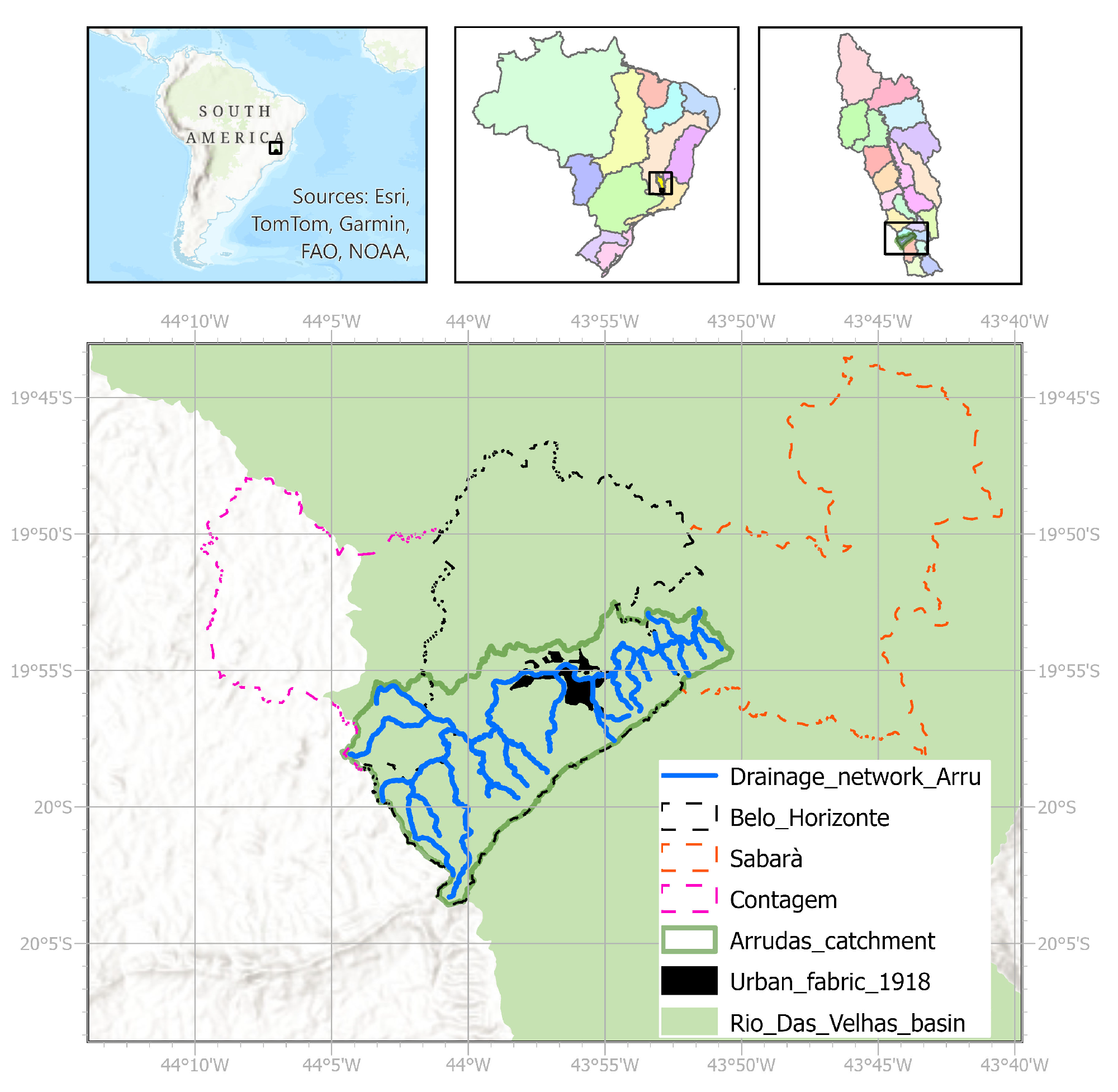
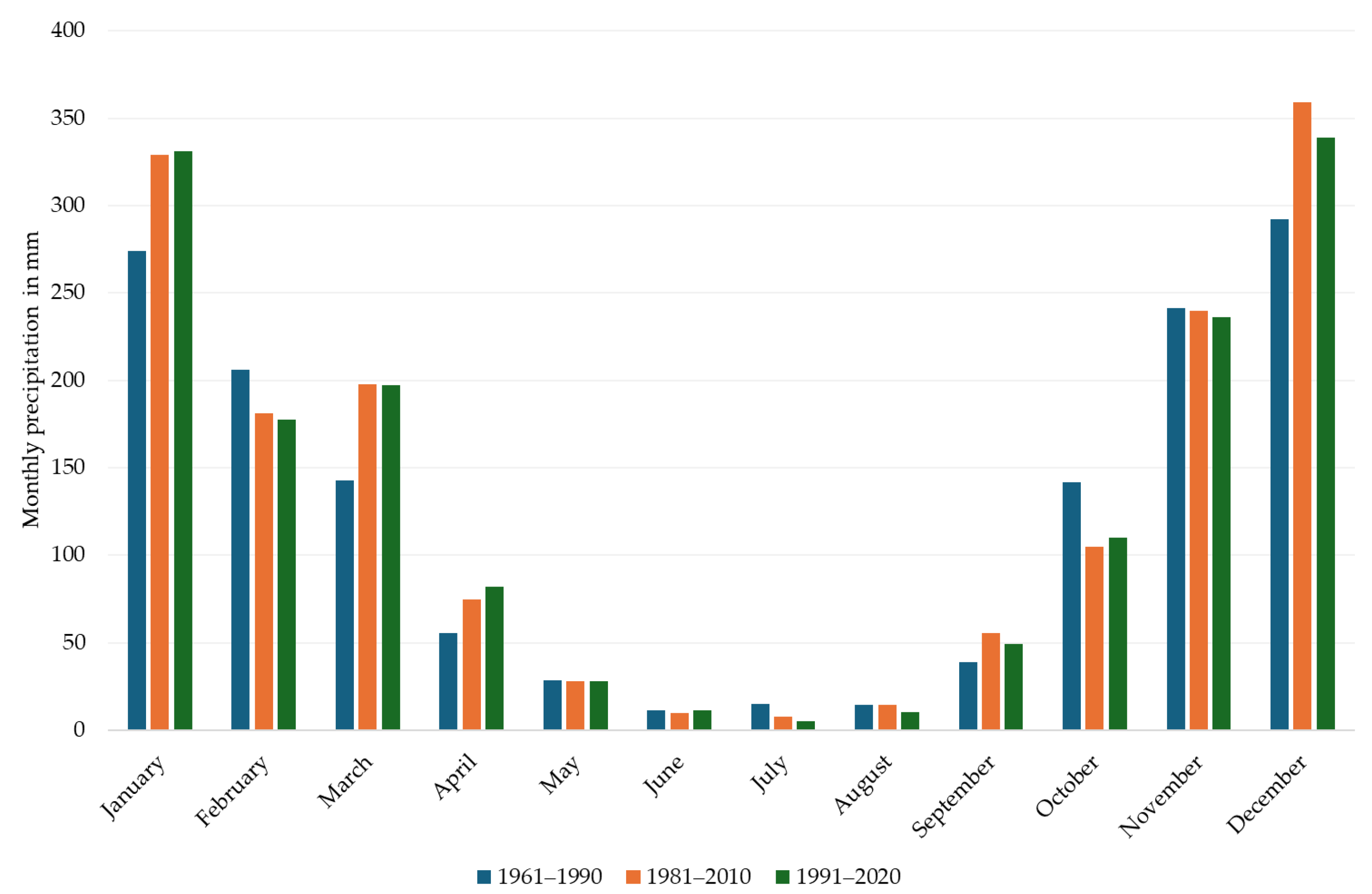
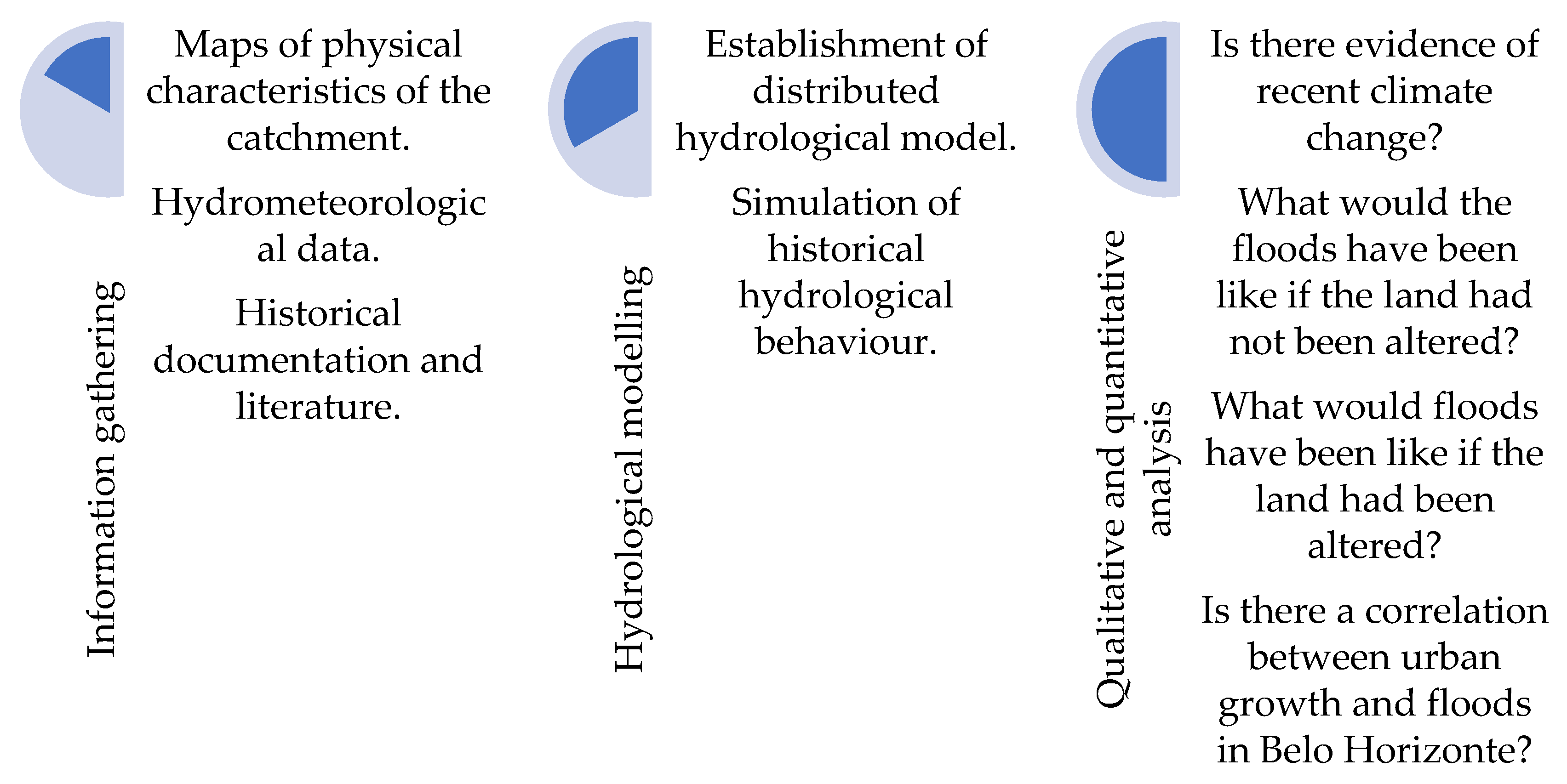

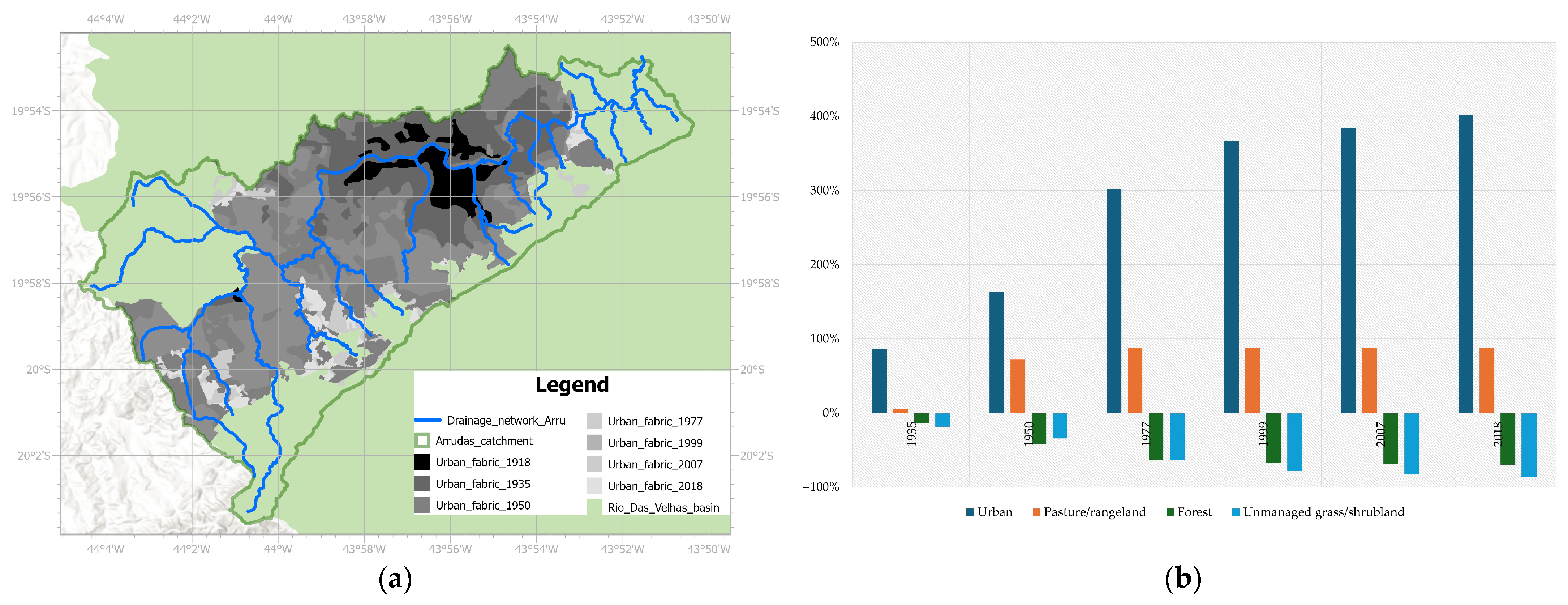
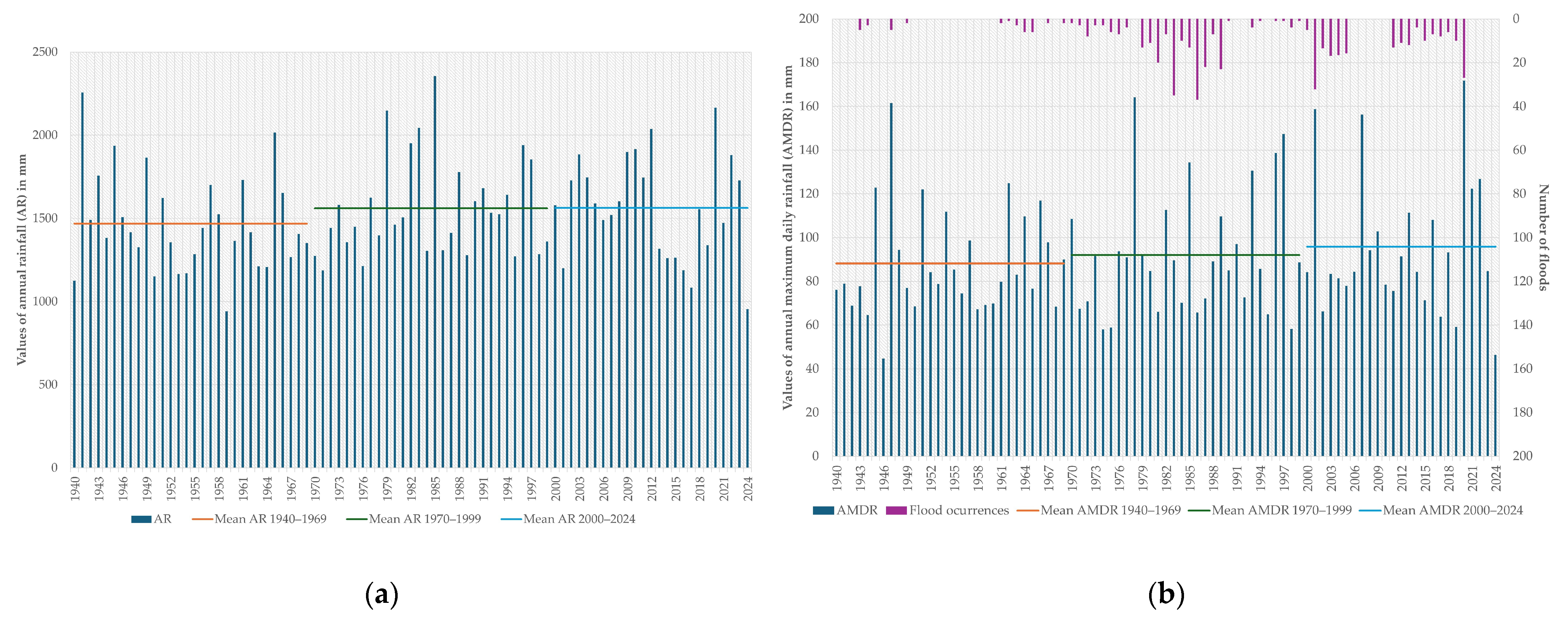
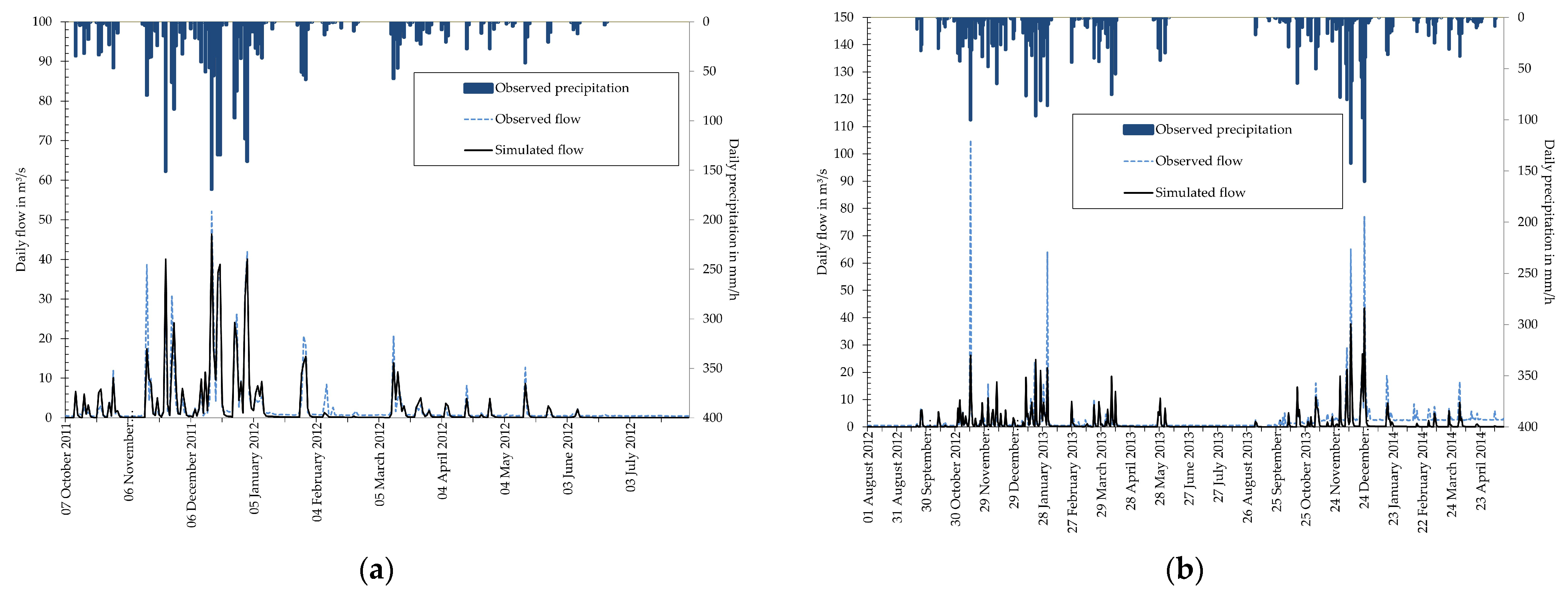
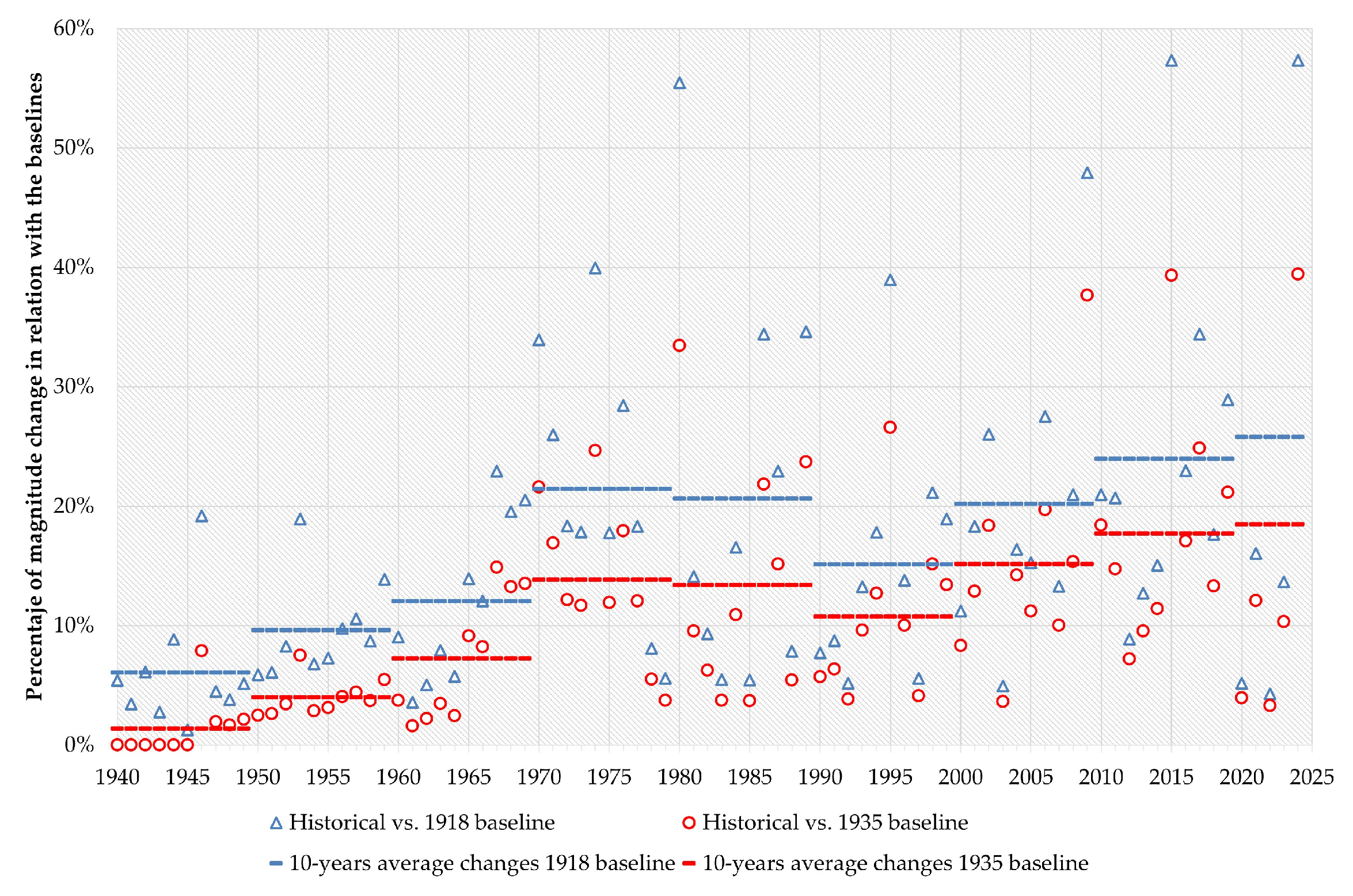
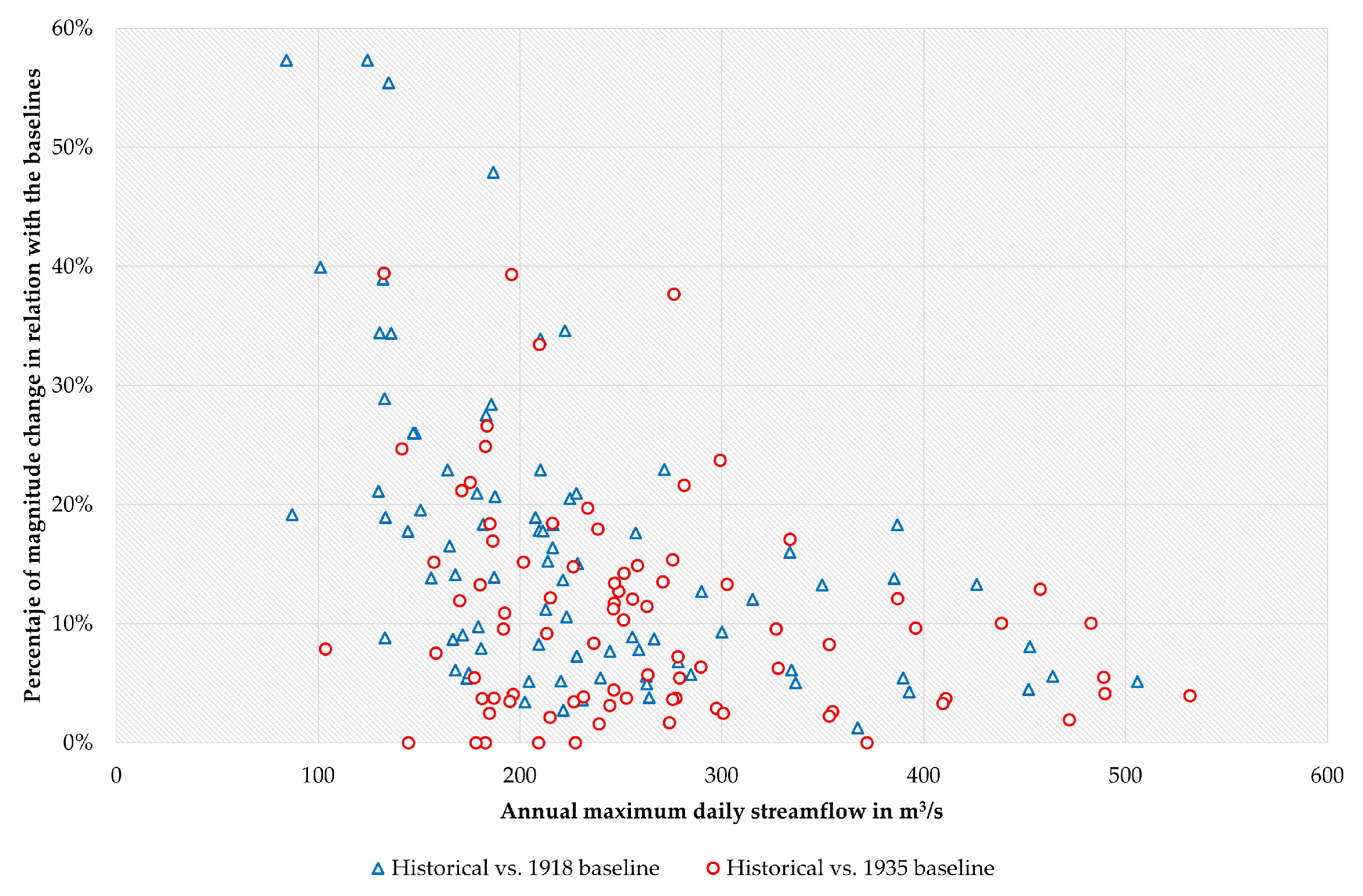

| Quartile | Total Annual Rainfall (mm) | Annual Maximum Daily Rainfall (mm) | ||||
|---|---|---|---|---|---|---|
| 1940–1969 | 1970–1999 | 2000–2024 | 1940–1969 | 1970–1999 | 2000–2024 | |
| Minimum | 941.8 | 1187.4 | 954.7 | 44.6 | 58.0 | 46.4 |
| 1Q | 1271.2 | 1319.9 | 1317.2 | 71.0 | 70.4 | 78.0 |
| 2Q | 1411.3 | 1485.0 | 1579.6 | 79.4 | 89.0 | 84.4 |
| 3Q | 1646.1 | 1671.6 | 1746.9 | 98.5 | 105.7 | 108.1 |
| Maximum | 2257.6 | 2356.6 | 2166.3 | 161.5 | 164.2 | 171.8 |
| Annual Maximum Daily Streamflow for Various Return Periods | ||||||||
|---|---|---|---|---|---|---|---|---|
| Historical land use conditions | 2 | 5 | 10 | 25 | 50 | 100 | 500 | 1000 |
| 1918 baseline | 213.6 | 295.0 | 350.4 | 422.1 | 476.7 | 532.3 | 667.3 | 728.6 |
| 1935 baseline | 223.0 | 303.6 | 358.9 | 431.1 | 486.5 | 543.3 | 683.0 | 747.1 |
| Historical land uses | 245.0 | 326.5 | 382.6 | 456.0 | 512.6 | 570.9 | 715.1 | 781.7 |
| Comparison | Percentage of change for various return periods | |||||||
| Historical land uses vs. 1918 baseline | 14.7% | 10.7% | 9.2% | 8.0% | 7.5% | 7.2% | 7.2% | 7.3% |
| Historical land uses vs. 1935 baseline | 9.9% | 7.5% | 6.6% | 5.8% | 5.4% | 5.1% | 4.7% | 4.6% |
Disclaimer/Publisher’s Note: The statements, opinions and data contained in all publications are solely those of the individual author(s) and contributor(s) and not of MDPI and/or the editor(s). MDPI and/or the editor(s) disclaim responsibility for any injury to people or property resulting from any ideas, methods, instructions or products referred to in the content. |
© 2025 by the authors. Licensee MDPI, Basel, Switzerland. This article is an open access article distributed under the terms and conditions of the Creative Commons Attribution (CC BY) license (https://creativecommons.org/licenses/by/4.0/).
Share and Cite
Salazar-Galán, S.; Granha Magalhães Gomes e Silva, A.; Sánchez-Fuentes, D.; Mascort-Albea, E.J. Is There a Historical Relationship Between Urban Growth and Resilience Loss? The Case of Floods in Belo Horizonte (Brazil). Sustainability 2025, 17, 8110. https://doi.org/10.3390/su17188110
Salazar-Galán S, Granha Magalhães Gomes e Silva A, Sánchez-Fuentes D, Mascort-Albea EJ. Is There a Historical Relationship Between Urban Growth and Resilience Loss? The Case of Floods in Belo Horizonte (Brazil). Sustainability. 2025; 17(18):8110. https://doi.org/10.3390/su17188110
Chicago/Turabian StyleSalazar-Galán, Sergio, Amanda Granha Magalhães Gomes e Silva, Domingo Sánchez-Fuentes, and Emilio J. Mascort-Albea. 2025. "Is There a Historical Relationship Between Urban Growth and Resilience Loss? The Case of Floods in Belo Horizonte (Brazil)" Sustainability 17, no. 18: 8110. https://doi.org/10.3390/su17188110
APA StyleSalazar-Galán, S., Granha Magalhães Gomes e Silva, A., Sánchez-Fuentes, D., & Mascort-Albea, E. J. (2025). Is There a Historical Relationship Between Urban Growth and Resilience Loss? The Case of Floods in Belo Horizonte (Brazil). Sustainability, 17(18), 8110. https://doi.org/10.3390/su17188110







